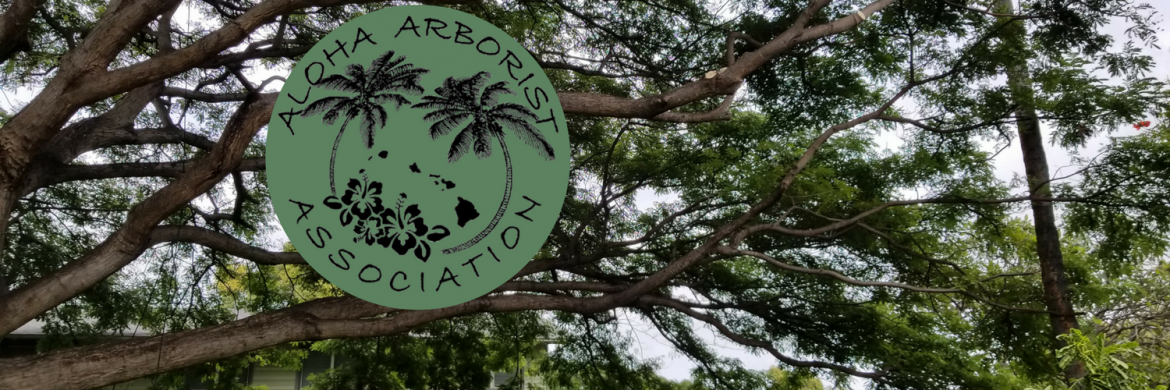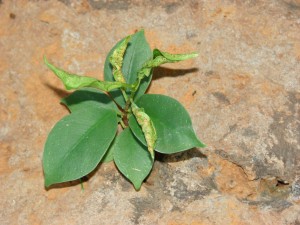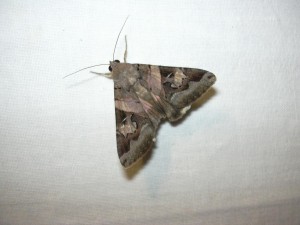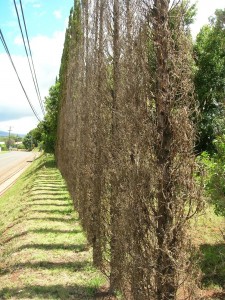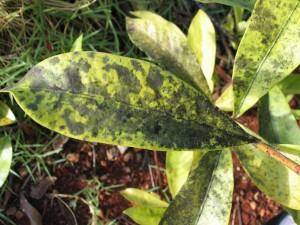Author's posts
Jun 27
Pest of the Month September 2010 – Citrus Leaf Miner
Hosts: species of Citrus and related Rutaceae Distribution: Hawaii, California, Florida, most of Africa, Australia, Saudi Arabia to India, Indonesia, China, Philippines, Taiwan, southern Japan, New Guinea and nearby Pacific Islands Symptoms: Serpentine mines in leaves and rarely in fruits, curling of leaves. Young leaves are susceptible. Succulent branches of young shoots may also be …
Jun 22
Pest of the Month August 2010 – Cuban Laurel Thrips
Host: Ficus sp., citrus, and occasionally orchids Distribution: Hawaii, Florida, California, Texas, Guam, and other tropical areas Symptoms: Sunken purplish spots along midrib and tight curling of young leaves, which become hard and tough and eventually fall off. Young leaves are susceptible. Management: Biological control including green lacewing larvae and ladybird beetles. For ornamental trees, …
Jun 22
Pest of the Month July 2010 – Colletotrichum Leaf Spot on Red Sealing Wax Palm
Host: Red sealing wax palms (Cyrtostachys renda Blume) Symptoms: Small, water-soaked dark green spots that expand into circular spots with tan to light brown centers bordered by water-soaked tissue on foliage. The size of necrotic areas increases as spots coalesce. Young leaves are susceptible. Leaf petioles and sheaths are also infected. Spread by: water splashing …
Jun 22
Pest of the Month June 2010 – Monkeypod Moths
Monkeypod Moths (Melipotis indomita, Ascalapha odorata, and Polydesma umbricola) Distribution: all major Hawaiian Islands Hosts: Monkeypods (M. indomita also attacks kiawe) Symptoms: Defoliation. Webbing with frass on trunk bark. Management: Management is not usually necessary. If a tree is particularly stressed, insecticide can be applied to the trunk bark. Sources: Description and Life Cycle of …
Jun 22
Pest of the Month May 2010 – Pacific Beetle Roach
Distribution: Asia, Pacific Islands, and Hawaii Hosts: Cypress and juniper Symptoms: Dead areas in crowns (orange/brown). Roaches girdle branches by eating the bark. Management: Remove leaf litter from crown and below tree (nesting area for roaches). Sources: Pacific beetle mimic Diploptera punctata Norfolk Island Pine Culture, University of Hawaii Cooperative Extension Service Circular 453, March 1972, p. …
Jun 22
Pest of the Month April 2012 – Black Twig Borer
Black Twig Borer Xylosandrus compactus (Eichoff) Distribution: Hawaiian Islands. Native to Asia, found in coffee growing areas of the world Hosts: Over 200 plant species including coffee, avocado, citrus, cacao, paperbark, Eucalyptus robusta, haole koa, guava, Christmasberry, lychee, macadamia, mango, mahogany, hibiscus, kukui,Surinam cherry, and podocarpus. Symptoms: Pin-sized entry holes, twig death. Severe infestations can kill …
Jun 22
Pest of the Month March 2012 – Banana Moth
Distribution: Islands of Oahu and Hawaii Host: Mortality in Hawaii has been found in Pritchardia sp., floribunda palm, foxtail palm, Manila palm, and coconut palm. Alternate hosts include grasses, banana, and coffee as well as in any decaying vegetation Symptoms: Browning of leaves, heart leaves easily pulled out with necrosis of living stem tissues beneath, heart …
Jun 22
Pest of the Month February 2010 – Nettle Caterpillar
Hosts: Over 45 species of plants in 22 families. Monocots preferred over dicots. Common in palms, various grasses, ti leaf, iris, and most lilies including mondo. Range: Most of east side of BigIsland, Kona district and Kohala district; Oahu (Central Oahu, Waimanalo, Waialua); and Maui (Haiku, Paia, Makawao, Wailuku, and Kihei) Symptoms: Heavily damaged leaves, …
Jun 22
Pest of the Month January 2010 – Sooty Mold
Hosts: Any plant that hosts phloem-feeding insects and has honeydew on it Range: Throughout the world’s temperate and tropical regions Symptoms: A black, non-parasitic superficial growth on plant surfaces that can be completely rubbed off with your fingers to reveal healthy plant tissue Spread through: airborne sooty mold spores Control: management is only warranted when …
Jun 21
Pest of the Month November 2009 – Coconut Leafroller
Hosts: Coconuts, bananas, native Pritchardias Range: All major Hawaiian Islands. More prevalent in windswept areas, possibly due to wind interference with parasitoids. Believed to be endemic to Hawaii. Symptoms: Young larvae feed on underside of leaves beneath a protective thin web of silk. They leave the opposite epidermis intact. As they get older, they feed …
